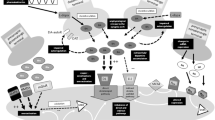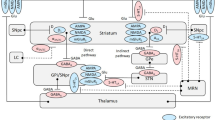Summary
In animal models of Parkinson's disease (PD), glutamate antagonists diminish levodopa (LD)-associated motor fluctuations and dyskinesias. We sought to investigate if these preclinical observations can be extended to the human disease, by evaluating the effects of three non-competitive NMDA antagonists (dextrorphan, dextromethorphan and amantadine) on the motor response to LD in patients with advanced PD. In four separate trials, adjuvant therapy with these drugs reduced LD-induced dyskinesias and motor fluctuations. These findings support the view that drugs acting to inhibit glutamatergic transmission at the NMDA receptor can ameliorate LD associated motor response complications.
Similar content being viewed by others
References
Albin RL, Young AB, Penny JB (1989) The functional anatomy of basal ganglia disorders. Trends Neurosci 12: 366–375
Bergman H, Wichmann T, DeLong MR (1990) Reversal of experimental parkinsonam by lesions of the subthalamic nucleus. Science 249: 1436–1438
Bernheimer H, Birkmayer W, Hornykiewicz O, Jellinger K, Seitelberg F (1973) Brain dopamine and the syndromes of Parkinson and Huntington. Clinical, morphological and neurochemical correlations. J Neurol Sci 20: 415–455
Blanchet PJ, Konitsiotis S, Chase TN. Amantadine reduces levodopa-induced dyskinesias in parkinsonian monkeys. Mov Disord (submitted)
Blanchet PJ, Metman LV, Mouradian MM, Chase TN (1996) Acute pharmacologic blockade of dyskinesias in Parkinson's disease. Mov Disord 11: 580–581
Bresink I, Danysz W, Parsons CG, Mutschler E (1995) Different binding affinities of NMDA receptor channel blockers in various brain regions — indication of NMDA receptor heterogeneity. Neuropharmacology 34: 533–540
Brotchie JM, Mitchell IJ, Sambrook MA, Crossman AR (1991) Alleviation of parkinsonism by antagonism of excitatory amino acid transmission in the medial segment of the globus pallidus in rat and primate. Mov Disord 6: 133–138
Chase TN, Engber TM, Mouradian MM (1996) Contribution of dopaminergic and glutamatergic mechanisms to the pathogenesis of motor response complications in Parkinson's disease. Adv Neurol 69: 497–501
Debonnel G, de Montigny C (1996) Modulation of NMDA and dopaminergic neurotransmissions by sigma ligands: possible implications for the treatment of psychiatric disorders. Life Sci 58: 721–734
Dogali M, Fazzini E, Kolodny E, Eidelberg D, Sterio D, Devinsky O, Beric A (1995) Stereotactic ventral pallidotomy for Parkinson's disease. Neurology 45: 753–761
Engber TM, Papa SM, Boldry RC, Chase TN (1994) NMDA-receptor blockade reverses motor response alterations induced by levodopa. Neuroreport 5: 2586–2588
Kornhuber J, Bormann J, Hubers M, Rusche K, Riederer P (1991) Effects of the 1-aminoadamantanes at the MK-801-binding site of the NMDAreceptor-gated ion channel: a human postmortem brain study. Eur J Pharmacol 206: 297–300
Kornhuber J, Schoppmeyer K, Riederer P (1993) Affinity of 1-amino-adamantanes for the sigma binding site in post-mortem human frontal cortex. Neurosci Lett 163: 129–131
Laitinen LV, Bergenheim AT, Hariz MI (1992) Ventroposterolateral pallidotomy can abolish all parkinsonian symptoms. Stereotact Funct Neurosurg 58: 14–21
Marsden C (1994) Problems with long-term levodopa therapy for Parkinson's disease. Clin Neuropharmacol 17 [Suppl 2]: S32-S44
Papa SM, Boldry RC, Engber TM, Kask AM, Chase TN (1995) Reversal of levodopainduced motor fluctuations in experimental parkinsonism by NMDA receptor blockade. Brain Res 701: 13–18
Papa SM, Chase TN (1996) Levodopa induced dyskinesias improved by a glutamate antagonist in parkinsonian monkeys. Ann Neurol 39: 574–578
Rupniak NM, Boyce S, Steventon MJ, Iversen SD, Marsden CD (1992) Dystonia induced by combined treatment with L-Dopa and MK-801 in parkinsonian monkeys. Ann Neurol 32: 103–105
Starr MS (1995) Glutamate/dopamine Dl/D2 balance in the basal ganglia and its relevance to Parkinson's disease. Synapse 19: 264–293
Tortella FC, Pellicano M, Bowery NG (1989) Dextromethorphan and neuromodulation: old drug coughs up new activities. Trends Pharmacol Sci 10: 501–507
Wong BY, Coulter DA, Choi DW, Prince DA (1988) Dextrorphan and dextromethorphan, common antitussives, are antiepileptic and antagonize N-methyl-D-aspartate in brain slices. Neurosci Lett 85: 261–266
Zhang Y, Britto MR, Valderhaug KL, Wedlund PJ, Smith RA (1992) Dextromethorphan: enhancing its systemic availability by way of low-dose quinidine-mediated inhibition of cytochrome P4502D6. Clin Pharmacol Ther 51: 647–655
Author information
Authors and Affiliations
Rights and permissions
About this article
Cite this article
Metman, L.V., Del Dotto, P., Blanchet, P.J. et al. Blockade of glutamatergic transmission as treatment for dyskinesias and motor fluctuations in Parkinson's disease. Amino Acids 14, 75–82 (1998). https://doi.org/10.1007/BF01345246
Received:
Accepted:
Issue Date:
DOI: https://doi.org/10.1007/BF01345246




